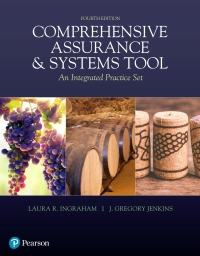

Taylor Jenkins jumped out of his chair. Harrington Chemicals, a sales lead that Taylor had been working on for six months, had just placed its first order for 10.000 bottles of Omnigar. To get the order, Taylor had had to promise a delivery date of May 20. Though he didn't take the time to check with the production scheduler, he was sure the company wouldn't have any problems filling an order for this important new customer. Harrington's order was more than enough to push Taylor over the April bonus threshold. Since Taylor was retiring at the end of April, it would be a satisfying way to end his 30-year career. If the company missed the delivery date, he would be long zone by the , time it happened Harrington's order was not met with much enthusiasm when it reached the desk of production scheduler Missy Price. "What was Jenkins thinking when he promised a May 20 delivery date?" she complained. "He knows I have to approve all the delivery dates. We've already scheduled all our available labor for May on the Omnigar line." Purchasing agent Pat Melton's reaction was similar. "I don't know where I'll get the raw materials for those extra 10.000 bottles. Our supplier is running low and only has enough material for the 12,000 bottles already scheduled for May." In response to these concerns. Omnigar's production manager, Charles Elliot called a meeting to decide how to handle the Harrington order without disrupting the schedule. Pat Melton reported, "Another supplier of raw materials is willing to ship to us, but we have to commit to buy 20,000 pounds at a total cost of $150,000. He promises that the materials are the same quality as those we normally use" Missy Price reported that she could move Class Il labor from another product to help with the extra 10,000 bottles. The standard wage for Class Il labor is $14 per direct labor hour. The standard direct materials and labor costs for one bottle of Omnigar are as follows: Direct materials: 1.5 pounds at 58 per pound Direct labor: 1.2 Class III direct labor hours at $12 per direct labor hour At the end of May, Controller Aiden Brown called Charles to discuss the month's results. , Alden: Charles Alden: Charles, what's up with Omnigar this month? You're usually right on target with standard costs. Just glancing at this performance report makes me think there must be a huge labor variance. Can you give me some Insight before I start crunching the numbers? I'm not surprised. Everything seemed to go wrong in May, but none of it was under my control. We were all set to produce 12.000 bottles of Omnigar based on the orders we had in house. Then Taylor Jenkins decided to do the company one last favor before he retired by accepting a rush order from Harrington Chemical for 10,000 more bottles. He promised a firm delivery date of May 20 without checking with anyone to see if we could meet it. I was able to work with Missy to move some Class Il workers over to Omnigar. And as you know they earn $2 more per hour than the Class Ill workers who normally work the Omnigar line. If I could have done all the production with Class ill workers, I think the labor rate variance would have been negligible , I didn't know that Class I workers knew how to make Omnigar. I bet their inexperience affected their productivity as well. . Luckily, the Classil workers got up to speed quickly. The real problem was with the raw materials Pat purchased to do the Harrington order. I know she did the best she could under the circumstances. Our regular supplier couldn't provide any more materials, so Pat found a new supplier with a great price. He promised that the materials were the same quality as those we usually buy, but they were nowhere near the same quality as those of our regular supplier. Spoilage went through the roof! The problem was, we couldn't tell whether the material was good or bad until we had almost finished production. And the error rate didn't , seem to be affected by the class of workers we used. . Well, it certainly sounds as if this was an atypical month for your group. Do you have any information that will help me to analyze the problem? Yes. I do. And I think all the variances need to be charged to the sales department, not to me. They are the ones who caused all the problems by accepting the Harrington order and promising delivery on May 20. . I , . Charles Aiden Charles To get a better picture of the problem, Aiden drew up the following breakdown of the production costs associated with the two different materials: Regular Materials Alternative Materials Direct materials used in pounds) 18,200 19,800 Production (in bottles) Class III workers 7,200 5,800 Class II workers 4,800 4,200 Total production 12,000 10,000 Actual direct labor hours Class III workers 8,600 7.900 Class II workers 5,900 5,700 Total direct labor hours 14,500 13,600 Class II Class III Actual direct labor payroll $163,770 $216,600 (b) e Your answer is partially correct. Calculate a labor rate variance analysis by worker class for Aiden. Direct labor rate variance Class III 34230 F Class II $ 54200 e Textbook and Media Save for Later Attempts: 1 of 4 used Submit








